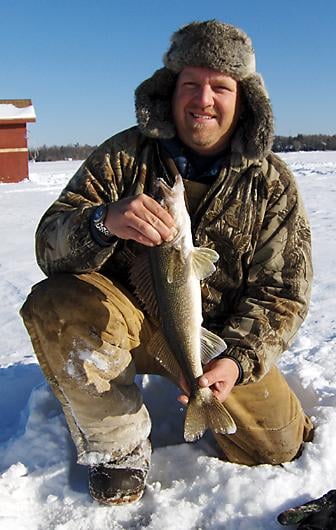Walleye Slot On Red Lake
Upper Red Lake, MN
At 288,800 acres, Red Lake is the largest of all inland lakes in Minnesota. It’s also at the center of one of the most tragic fisheries failures, and at the same time, the subject of perhaps the most successful joint recovery effort in fishing history.
The lake is split into upper and lower basins, with all of Lower Red Lake and about 60% of Upper Red Lake under the jurisdiction of the Red Lake Band of Chippewa Indians. The remaining waters fall under state authority. Historically, the lake was a virtual walleye factory, but in the late 1990s overharvest led to a total collapse of the fishery.

An unprecedented cooperative effort between the Band and the state, which included stocking 90,000,000 walleye fry over six years, a seven-year moratorium on walleye fishing, and later on, more restrictive sport and commercial fishing regulations, has led to what all agree is a lake that’s loaded with walleyes.

About 48,000 acres of Upper Red Lake is open to non-tribal sportfishing, and typically carries a slot limit to protect the fishery, so check fishing regulations before you hit the water.
Red is a very unique situation since a huge portion of the lake is not open to hook and line anglers. That said, since these slots are only affecting a portion of the entire population there is definitely a possibility that allowing the harvest of more large fish by hook and line is the right move. Anglers who fish Upper Red Lake now may keep larger walleye, according to the Minnesota Department of Natural Resources officials. A protected slot limit requiring all walleye from 17 to 26 inches.
Walleye Slot Limit On Red Lake
Duane Peterson, Team Northland member and company co-founder, has fished Red Lake through its decline and resurrection and is on the citizen’s committee that helped steer recovery efforts, and current management plan.

“The beauty of Red Lake is that it’s easy to fish,” he says. “It’s basically a bowl with a sand/silt/mud bottom, a 15-foot maximum depth and very little structure. A person doesn’t need sophisticated sonar skills to be successful.”
Open-water fishing begins in mid-May, and through mid-June fish tend to congregate on the first breakline, which is typically from 3½ to 7 feet deep. “The No. 1 open-water presentation is a jig-and-minnow. Lots of jigs do the job—round balls, stand-ups—but for the past 15 years a 1/16- to 1/8-ounce Fire-Ball® Jig tipped with a shiner has been the most popular and productive.
Walleye Slot On Upper Red Lake
Walleye Slot On Red Lake
“Walleyes on Red are generally willing biters, but if they’re moody, many anglers fish a small jig-and-leech or ‘crawler under a float.”
After mid-June many fish disperse into the basin, and while many anglers catch plenty of fish from anchored positions, others do better by covering water. Peterson recommends a 3/8- to ½-ounce Rock-Runner® Slip-Bouncer in front of a single-hook spinner, such as a Baitfish Spinner Rig baited with a small minnow.
“I am partial to the Baitfish-Image series, however, plain metallic blades are hard to beat,” he says. “You don’t need a lot of speed—normally about .75 mph. The key is to watch the line and make sure it’s at a 45-degree angle to the water. That will keep the bait in the strike zone.”.